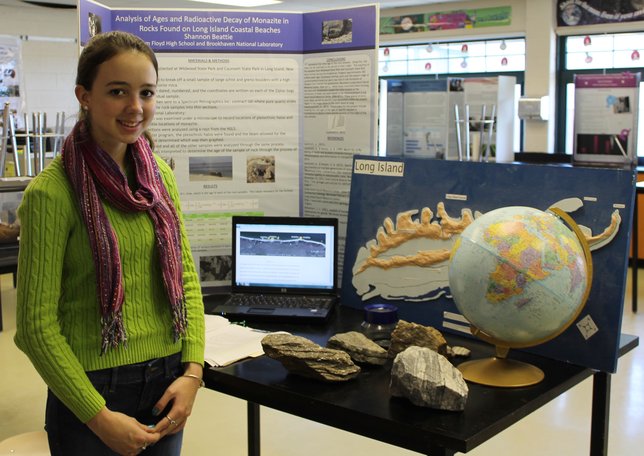Mastic Beach, NY - November 22, 2013 - William Floyd High School sophomore Shannon Beattie has been working with a team of science teachers and researchers from Brookhaven National Laboratory (BNL) and the Center for Advanced Radiation Sources at the University of Chicago, to determine the provenance (origin) of glacial erratics found on the north shore beaches of Long Island by analyzing a rare mineral found in them called monazite. The team presented their results in a poster presentation at a National Synchrotron Light Source (NSLS) user’s meeting at BNL held last spring.
Boulder samples were collected at Wildwood and Caumsett State Parks and analyzed at the NSLS using their X-ray fluorescence (XRF) microprobe beamline. Shannon and her collaborators employed a chemical-dating technique used on monazite to measure the uranium, thorium and lead concentration in the mineral to calculate the mineral’s age of crystallization. These calculated ages can be compared to published ages of similar basement rock from Connecticut and used to identify their origin.
“Although the timing of Pleistocene glaciations that formed Long Island’s surface topography are generally well understood, questions remain regarding how far the material in the moraines traveled,” said Robert Mozer, CPG, a William Floyd Middle School science teacher and poster co-author. A moraine is a mass of rocks and sediment carried and deposited by a glacier.
“Shannon’s involvement on the project has been much more than a student observing authentic research,” said Dr. Amy Meyer, William Floyd High School research teacher. “After some very brief introductory instructions, she was controlling the beamline used in the analysis of the specimens collected by the team. Shannon is in the second year of her research involvement and I am continually impressed by her dedication to the project and her ability to present the research with fluency and professionalism. Her research paper and poster presentation skills have impressed many from the scientific community.”
The team was able to identify several rocks from Long Island beaches that contained monazites suitable for chemical dating which, when analyzed, produced calculated ages of approximately 295 million years old; similar to Sevigny and Hanson’s calculations published in “Orogenic evolution of the New England Appalachians of southwestern Connecticut,” an article appearing in the Geologic Society of America Bulletin, a leading scholarly research journal for all branches of the earth sciences.
Dr. Antonio Lanzirotti, a geochemist from the University of Chicago who oversees the X-ray microprobe beamline at the NSLS, has also been impressed with Shannon. “She has been remarkably adept at developing the expertise to conduct a rather complicated geochemical experiment and to understand the physics behind how X-ray analytical techniques work,” said Dr. Lanzirotti. “The researcher needs a good grasp of geologic field methods out there on the beach and they need to be able to identify the correct rock types that may contain monazite. Not an easy task considering that, even in potentially suitable rock types, monazite typically makes up less than one percent of the minerals present.”
Dr. Lanzirotti continued, “The researcher also needs the skills to look at rock-thin sections under a petrographic microscope, identify potential mineral candidates for later XRF analysis and then, with the beamline instrument, verify that the minerals are in fact monazite based on the XRF spectrum collected. It doesn’t end there: they then need to conduct elemental quantification and using these values do an iterative calculation to constrain their age. Even professional scientists would struggle with this and that Shannon was able to find rocks that contained the monazites, identify them, analyze them and then calculate ages that make geologic sense is tremendously impressive. Now, she teaches new students in the project how to do this – she has become the expert.”
"In 2010, Brookhaven Lab launched ‘Introducing Synchrotrons into the Classroom’ (InSynC) to provide high school teachers and students access to an advanced U.S. Department of Energy scientific facility – our National Synchrotron Light Source, where Shannon accomplished much of her research,” said Scott Bronson, Manager of K-12 Programs for Brookhaven National Laboratory’s Office of Educational Programs. “Shannon’s experience of discovery is an example of the type of authentic inquiry-based learning that is crucial to developing the nation’s next-generation scientific workforce."
“This project has been such an incredible opportunity for me,” said Shannon. “I'm excited to learn about science and participate in an important project to discover the origin of glacial erratics on Long Island,” she said. “The experiences I've had as a part of this project have helped me to better understand science and research. My inspirational and patient mentors have helped me become more confident and helped to instill in me a passion for science.”
In the future, Shannon and the team plan to conduct additional XRF geochronology analysis of remaining rock sample sections and collect additional glacial erratic samples from various north shore beaches, including: Howard Reed State Park and beaches in Baiting Hollow and Belle Terre, NY. They also hope to continue opportunities for collaboration with middle school and high school earth science students across Long Island.
Eric Cafarella of Bellport High School and Nick Todaro of Northport High School have also contributed to this project.
Pictured: William Floyd High School student Shannon Beattie is pictured with her poster and some of the rock samples collected in the Monazite research project.










